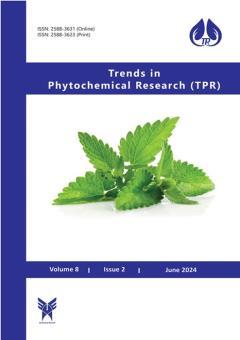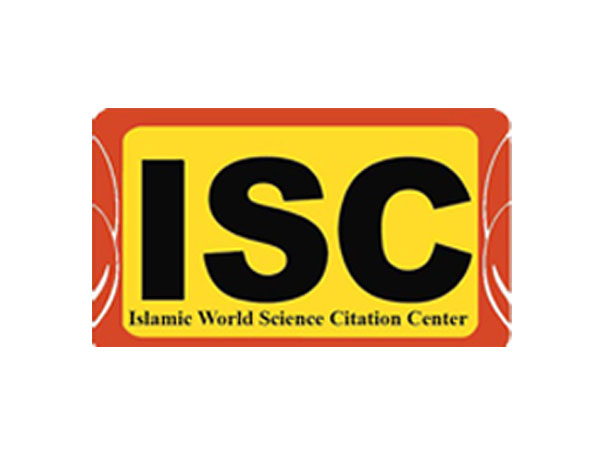About the journal

"Trends in Phytochemical Research (TPR)", is a prominent journal that publishes original research and review articles. It covers a wide range of topics including the characterization and processing of essential oils, analytical assessments of bioactive compounds, natural products chemistry, phytochemical evaluations of essential oils and extracts, and their antioxidant, antibacterial, antimicrobial, antifungal properties. The journal also explores areas such as food chemistry and the biological activities of naturally occurring compounds. The abbreviated form of this journal is "Trends Phytochem. Res.". TPR is an open access and a free of charge journal for all authors all over the world. In other words, there is no article processing charge for each accepted and subsequently published article in the journal.
"Trends in Phytochemical Research (TPR)" publishes original research articles, review papers, short communications, letter to editor, technical notes, and book reviews. At present, it publishes four issues per year. “Trends in Phytochemical Research (TPR)”, an international open access and quarterly journal that has been regularly published since March 2017. This journal has received an official approval from the 103rd session of the Journals Evaluation Committee of Islamic Azad University, Central Organization on 10 October 2016. The Editor-in-Chief of TPR is Prof. Majid Mohammadhosseini from the Chemistry Department of Islamic Azad University of Shahrood. This journal is published by Islamic Azad University, Shahrood Branch Press, Shahrood, Iran.
ISSN Print: 2588-3623
ISSN Online: 2588-3631
CODEN: TPR
Journal Home Page: http://tpr.iau-shahrood.ac.ir/
The headlines of Trends in Phytochemical Research (TPR) are as follows.
Analytical Chemistry Disciplines with Focus on Medicinal and Herbal Plants
Spectroscopy: Atomic and Molecular
Separation: Chromatography (GC, HPLC, GC-MS, Headspace…); Extraction (SPME, …)
Hyphenated techniques: GC-MS, Two Dimensional Gas Chromatography,….
Critical Reviews in Phytochemistry
Food Science
Food Chemistry: Analysis, Sensory Evaluation,…
Quality control
Phytochemistry
Essential Oils: Classical and Advanced Techniques for Isolation of the Essential Oils, Antibacterial, Antimicrobial Evaluations, etc.
Extracts
Biotransformation
Pharmacognosy
Flavor, Perfumes and Cosmetics
Pharmaceutical Formulations and Herbal Drugs
Ethnopharmaceutical Reports
Ethnopharmacology
Computational and Theoretical Studies Related to Different Aspects of Phytochemistry
Considering the statistics of TPR in 2019, the acceptance rate the submitted articles was about 49%. The average time between submission and final decision is six to eight weeks and the average time between acceptance and publication is about one month.
.jpg)
The submitted papers are also tracked via reliable "Plagiarism Checker" like "iThenticate plagiarism checker" to make sure their originality. The other objective of our journal is to publish the highest quality articles and disseminate to all readers through our "Open Access" mode. The published articles are not recommended for commercial use.
-
Open Access Article
1 - Antioxidant properties and anticancer activity of Olea europaea L. olive and Ficus carica fruit extracts against pancreatic cancer cell lines
Nadia Nadia Dekdouk Souad Ameddah Chawki Bensouici Meghboun Ibtissem Menad Ahmed Fátima MartelIssue 2 , Vol. 8 , Summer 2024Olea europaea (OFE) and Ficus carica (FFE) extracts have shown anticancer activity. The currents report, we aim to evaluate the phytochemical composition, antioxidant properties and anticancer activity of OFE and FFE against PANC-1 and AsPC-1 pancreatic cancer cell line MoreOlea europaea (OFE) and Ficus carica (FFE) extracts have shown anticancer activity. The currents report, we aim to evaluate the phytochemical composition, antioxidant properties and anticancer activity of OFE and FFE against PANC-1 and AsPC-1 pancreatic cancer cell lines. OFE possessed higher phenolic, flavonoid content and antioxidant ability than FFE. OFE and FFE induced a cytotoxic effect and their combination resulted in an increased cytotoxicity. OFE showed an antiproliferative effect while FFE had no effect. Combination of the two extracts resulted in an antiproliferative effect similar to that of OFE. OFE showed an antimigratory effect, while FFE exhibited a promigratory effect. Interestingly, combination of the two extracts resulted in an anti-migratory effect similar to that caused by OFE. In view of the findings of this study, these extracts could be considered potential sources of natural compounds with antioxidant and anti-pancreatic cancer effects. The combination of these extracts should be further investigated in the context of pancreatic cancer. Manuscript profile -
Open Access Article
2 - Phytochemical characterization and biological properties of Ocimum sanctum L. and its active phytocomponents: Eugenol and β-caryophyllene
Krupali Trivedi Nilam Parmar Khairah Ansari Vaibhavi Srivastava Nishi Modi Devendrasinh JhalaIssue 2 , Vol. 8 , Summer 2024This study explored the pharmacognostical and biological properties of Ocimum sanctum L., focusing on its hydromethanolic (HME) and aqueous (AQE) extracts, as well as the bioactive compounds eugenol (EUG) and β-caryophyllene (BCP). Phytochemical analysis revealed a dive MoreThis study explored the pharmacognostical and biological properties of Ocimum sanctum L., focusing on its hydromethanolic (HME) and aqueous (AQE) extracts, as well as the bioactive compounds eugenol (EUG) and β-caryophyllene (BCP). Phytochemical analysis revealed a diverse range of compounds, with HME showing higher levels of phenolics, flavonoids, and tannins compared to AQE. Both extracts exhibited antioxidant activity, while EUG and BCP displayed significant cytotoxicity against MCF-7 cells. Molecular docking studies indicated that EUG has potential binding to catalase. The findings of this study underscore O. sanctum as a valuable source of bioactive compounds with potential antioxidant and anticancer properties. Notably, the extraction method played a crucial role in determining the phytochemical profile. However, further investigations are necessary to fully understand the mechanisms and therapeutic applications of EUG and BCP, particularly as potential catalase inhibitors. Manuscript profile -
Open Access Article
3 - Characterization of pharmacological properties and isolation of two bioactive compounds (ursolic acid and palmitoleic acid) from the stem bark extract of Lannea coromandelica
Ramisa Anjum A.H.M. Nazmul Hasan Mst. Al Asma Hawa Md. Khokon Miah Akanda Tania Binte Wahed Fayad Bin Abdus Salam Md. Rabiul Islam Rabiul Islam Mohammad ShahriarIssue 2 , Vol. 8 , Summer 2024The current research aimed to conduct a bioassay-guided isolation of bioactive compounds from the stem bark of Lannea coromandelica. Using column chromatography and NMR spectroscopy, two compounds -ursolic acid and palmitoleic acid- were isolated from the plant’s stem b MoreThe current research aimed to conduct a bioassay-guided isolation of bioactive compounds from the stem bark of Lannea coromandelica. Using column chromatography and NMR spectroscopy, two compounds -ursolic acid and palmitoleic acid- were isolated from the plant’s stem bark. The methanolic stem bark extract possessed higher total phenolic, flavonoid, and antioxidant capacity content than the n-hexane extract. The IC50 value of the methanol and n-hexane stem bark extracts for DPPH free radical scavenging potential was found to be 37.37 and 27.726 μg/mL, respectively, while for nitric oxide, the IC50 value was 14.615 and 22.136 μg/mL, respectively. The n-hexane extract exhibited higher antidiabetic effectiveness (46% blood glucose reduction) than the methanolic extract (37.8% blood glucose reduction) after 3 hours of glucose administration in mice model at a dose of 400 mg/kg body weight (p < 0.001). The methanolic extract demonstrated the highest anti-diarrheal action at a dose of 400 mg/kg body weight (88.70% inhibition of defecation, p < 0.001). Furthermore, the n-hexane extract showed the highest analgesic activity (70.5% inhibition of writhing, p < 0.01). Manuscript profile
-
Open Access Article
1 - Herbal cosmeceuticals: New opportunities in cosmetology
Mohd Aqil Aiswarya Chaudhuri Abdul QadirIssue 3 , Vol. 4 , Summer 2020Cosmeceuticals are defined as cosmetic products designed to improve and enhance the physical appearance, beauty, health as well as to treat the skin ailments. The main objective of the present review is to document various plants along with their active phytochemicals l MoreCosmeceuticals are defined as cosmetic products designed to improve and enhance the physical appearance, beauty, health as well as to treat the skin ailments. The main objective of the present review is to document various plants along with their active phytochemicals like alkaloids, flavonoids, saponins, sterols, triterpenes, tannins, etc. responsible for activities like antioxidant, anti-inflammatory, sunlight protection, skin regeneration, de-pigmentation, anti-dandruff, anti-hair fall, anti-lice, etc. This study also provides an overview of geographical distribution, environmental attributes, extraction and isolation procedure of active phytochemicals responsible for biological activity. This review further tries to assess the regulatory scenario of cosmeceuticals as they are placed under the subclass of cosmetics under Europe and Japan regulations , whereas in US regulations, cosmeceuticals are placed under the subclass of drugs. The application of nanotechnology in formulating cosmeceuticals (nano-cosmeceuticals) has also seen the light of the day. It can be viewed as a “new paradigm” in the cosmetic industry. Manuscript profile -
Open Access Article
2 - A review on biosynthesis, regulation, and applications of terpenes and terpenoids
Anjali Singh Dhananjay Singh Sapna Sharma Nishu MittalIssue 4 , Vol. 7 , Autumn 2023Essential oils (EOs) are concentrated liquids extracted from various parts of plants and can be classified based on their phytochemical compounds. Terpenes and terpenoids have a wide range of biological activities, including anticancer, anti-inflammatory, antimicrobial, MoreEssential oils (EOs) are concentrated liquids extracted from various parts of plants and can be classified based on their phytochemical compounds. Terpenes and terpenoids have a wide range of biological activities, including anticancer, anti-inflammatory, antimicrobial, antioxidant, and antiallergic properties. Terpenes are plant-based compounds commonly used in the pharmaceutical, food, biofuel, and chemical industries by humans. In synthetic biology, genomic resources and emerging tools facilitate the production of high-quality terpenoids in plants and microbes. Terpenoids, however, are difficult to produce in large quantities due to their complex chemical structures and the limited amounts found in plants. The regulation of terpenoid biosynthesis has gradually emerged as a research priority. This review presents an overview of the biological activities, synthesis pathways, and key enzymes involved in the biosynthetic pathways and regulation of terpenes or terpenoids. This review will also include references for further research on molecular regulation, biological advancements, and increasing the content of terpenes or terpenoids in plants. Manuscript profile -
Open Access Article
3 - A mini review on therapeutic potentials of <i>Phyllanthus niruri</i> L.
Jeevani Maheshika Dahanayake Pathirage Kamal Perera Priyadarshani Galappaththy Menuka ArawwawalaIssue 3 , Vol. 4 , Summer 2020Phyllanthus niruri Linn belongs to plant family Euphorbiaceae and is found in tropical and subtropical countries of the world including some regions of Sri Lanka and India. The extract of P. niruri Linn is the most commonly used medicine in Ayurveda system of medicine a MorePhyllanthus niruri Linn belongs to plant family Euphorbiaceae and is found in tropical and subtropical countries of the world including some regions of Sri Lanka and India. The extract of P. niruri Linn is the most commonly used medicine in Ayurveda system of medicine and has especially been recommended for the treatment of bronchitis, anaemia, skin diseases, asthma, cough, liver, kidney and urinary tract disorders. In the present study, an attempt was done to document the scientific investigations on phytochemicals and pharmacological activities of P. niruri Linn. According to the findings of P. niruri Linn, it shows potent pharmacological actions on hepatitis B virus, liver carcinoma, kidney stones and HIV. The available research suggested that P. niruri Linn has many beneficial health effects. However, human based data are sparse and conducting clinical trials will be necessary to prove more public health implications. These findings may be considered as clues to the development of novel pharmaceutical preparations from P. niruri Linn in future. Manuscript profile -
Open Access Article
4 - Preliminary phytochemical screening for antioxidant activity and content of phenols and flavonoids of 18 species of plants native to western Ecuador
Shirley Moncayo Xavier Cornejo Jhon Castillo Viviana ValdezIssue 2 , Vol. 5 , Spring 2021The phytochemical screening, total phenolics and flavonoids content and antioxidant activity of plants native to western Ecuador were investigated to provide the basic information for further studies towards the discovery of new compounds. The species studied were Adeno MoreThe phytochemical screening, total phenolics and flavonoids content and antioxidant activity of plants native to western Ecuador were investigated to provide the basic information for further studies towards the discovery of new compounds. The species studied were Adenostemma platyphyllum Cass, Castilla elastica subsp . gummifera (Miq.) C.C. Berg., Cochlospermum vitifolium (Willd.) Spreng., Ectozoma pavonii Miers, Erythrochiton giganteus Kaastra & A.H. Gentry, Erythroxylum patens Ruiz ex O.E.Schulz, Ficus brevibracteata W.C. Burger, Ficus tonduzii Standl., Grias ecuadorica Cornejo & S.A. Mori, Handroanthus billbergii subsp . ampla (Bureau K. Schum.) S.O. Grose, Morisonia americana L., Operculina codonantha (Benth.) Hallier f., Passiflora macrophylla Spruce ex Mast., Podandrogyne jamesonii (Briq.) Cochrane, Pradosia montana T.D. Penn., Tecoma castaneifolia (D.Don) Melch, Urera baccifera (L.) Gaudich. ex Wedd., and Xanthosoma sagittifolium (L.) Schott.The highest percentage of inhibition of DPPH• was found in E. patens (92.41%). Most of the extracts evaluated exhibited antioxidant activity. Manuscript profile -
Open Access Article
5 - <i>Leucas aspera</i> (Willd.) L.: Antibacterial, antifungal and mosquitocidal activities
Manickam Pavunraj Ganapathy Ramasubbu Kathirvelu BaskarIssue 3 , Vol. 1 , Summer 2017The various organic extracts from the leaves of Leucas aspera were screened for their antibacterial, antifungal and larvicidal activities against selected bacterial, fungal strains and mosquito larvae of Culex quinquefasciatus. Antimicrobial activity was carried out usi MoreThe various organic extracts from the leaves of Leucas aspera were screened for their antibacterial, antifungal and larvicidal activities against selected bacterial, fungal strains and mosquito larvae of Culex quinquefasciatus. Antimicrobial activity was carried out using disc-diffusion method and MIC of the extract was tested by the broth micro-dilution method. The results revealed that all the extracts showed antibacterial and antifungal activities against selected microbes at 1, 2.5, 5 and 10 mg/disc concentrations. The maximum zone of inhibitions were recorded in dichloromethane (DCM) leaf extract of L. aspera against S. aureus (23.4 ± 2.90 mm), E. coli (20.3 ± 1.56 mm), B. subtilis (17.1 ± 2.04 mm), P. aeruginosa (16.5 ± 1.05 mm), P. vulgaris (16.1 ± 2.56 mm) and K. pneumonia (15.1 ± 3.66 mm) at 10 mg/disc concentration. The DCM extract of L. aspera exhibited significant growth inhibition against T. viride (29.2 ± 2.00 mm), C. albicans (24.4 ± 0.80 mm), A. flavus (22.8 ± 0.36 mm) and E. floccosum (19.5 ± 2.17 mm). The minimum inhibitory concentration (MIC) ranges between 75.5-425.5 µg/mL and 125-425 µg/mL against bacterial and fungal pathogens, respectively. In addition, DCM extracts of L. aspera showed 100% larvicidal activity against C. quinquefasciatus at 1000 ppm concentration. The biological activities could contribute to the medicinal properties of the plants, and also provide more scientific authentication of traditional medicinal plants to fight against the various infectious diseases Manuscript profile -
Open Access Article
6 - Nano-encapsulation of thyme essential oil in chitosan-Arabic gum system: evaluation of its antioxidant and antimicrobial properties
Maryam Hassani Shirin HasaniIssue 2 , Vol. 2 , Spring 2018In this study Nano–capsules based on chitosan (CS) and Arabic Gum (GA) with Thyme essential oil (TEO) as an active ingredient were prepared using emulsion method. The nano–capsules were characterized by their Encapsulation efficiency (EE), morphologies, Part MoreIn this study Nano–capsules based on chitosan (CS) and Arabic Gum (GA) with Thyme essential oil (TEO) as an active ingredient were prepared using emulsion method. The nano–capsules were characterized by their Encapsulation efficiency (EE), morphologies, Particle size distributions, Zeta potential and Release (RE). Results showed that nano–capsules produced by using relative ratio CS: GA (1.5%:8.5%) clearly showed the highest Encapsulation efficiency (77.67%) and Zeta potential value (+ 43.17 mV). In vitro release studies demonstrated a prolonged release for the samples with larger CS ratio. Most nano–capsules sizes ranged from 385.2 to 756.1 nm. Scanning electron microscopy (SEM) images showed nano–capsules had a rough surface without the spherical shape for all samples. Quantitative values of antioxidant activity of Thyme essential oil and nano–encapsulated essential oil were studied. The essential oils were investigated for their antibacterial activity against common Gram–positive and Gram–negative pathogenic microorganisms (Staphylococcus aureus and Escherichia coli) by Disk diffusion and dilution method (MIC). Our results reported the better antioxidant and antibacterial effects of the encapsulated TEO in comparison with free TEO. Finally, the mixture of CS: GA at (1.5%:8.5%) can be suggested as suitable wall material for Thyme essential oil encapsulation. Manuscript profile -
Open Access Article
7 - Simultaneous optimization of extraction of bioactive compounds and antioxidant activity of Ammi visnaga (L.) Lam aerial parts using response surface methodology
Zineb El Jabboury Smail Aazza Driss Ousaaid Oumaima Chater Uroš Gašić Peđa Janaćković Zora Dajic Stevanovic Stefan Kolašinac Meryem Benjelloun Lahsen El GhadraouiIssue 1 , Vol. 8 , Spring 2024In this report, different extracts from the aerial parts of Ammi visnaga (L.), e.g., flowers, leaves, and stems were prepared using water, methanol, and ethanol. To optimize the extraction process, the design of mixtures was carried out using different extracting solven MoreIn this report, different extracts from the aerial parts of Ammi visnaga (L.), e.g., flowers, leaves, and stems were prepared using water, methanol, and ethanol. To optimize the extraction process, the design of mixtures was carried out using different extracting solvents and their combinations. The special cubic model explained the variance of the TPC and the antioxidant activity of the extracts at a level of R2 > 95%. In general, the analysis of the model-derived response surfaces revealed that in binary mixtures (50% ethanol + 50% methanol), the yielded values of phenolic compounds and the antioxidant activity increase with the water proportion of different prepared mixtures. The ability of the quaternary mixture to extract the phenolic compounds was also positively and significantly influenced by the water content, creating a mild polar medium for the extraction of phenolic compounds. The phenolic profile of different extracts under study revealed the presence of a cocktail of active ingredients, including chlorogenic acid, caffeic acid, rutin, p-coumaric acid, etc. especially the flower extract of A. visnaga (L.). Manuscript profile -
Open Access Article
8 - Optimization of extraction methods for total polyphenolic compounds obtained from rhizomes of <i>Zingiber officinale</i>
Lida Eberle Alena Kobernik Aleksandra Aleksandrova Iryna KravchenkoIssue 1 , Vol. 2 , Winter 2018In an alternative medicine, aqueous extracts and decoctions of a ginger root (Ginger –Zingiber officinale Roscoe L., Ginger family – Zingiber aceae) are used as antibacterial, diaphoretic, analgesic, anti-emetic, anti-inflammatory drugs. The aim of our study MoreIn an alternative medicine, aqueous extracts and decoctions of a ginger root (Ginger –Zingiber officinale Roscoe L., Ginger family – Zingiber aceae) are used as antibacterial, diaphoretic, analgesic, anti-emetic, anti-inflammatory drugs. The aim of our study was to determine the optimal technological conditions of total polyphenolic compounds extraction under different extraction conditions from ginger roots. Ethanol extracts of the plant were obtained by maceration method, Soxleted apparatus and ultrasonic method. Polyphenol compounds and flavonoids were determined with the standard spectrophotometric methods using the Folin-Ciocalteu and differential spectrophotometry (complexation with AlCl3), respectively. It was found that the highest content of polyphenolic compounds and flavonoids from the raw material into the solvent system are determined after sonication followed by subsequent maceration during 10 (total polyphenolic compounds) and 7 days (flavonoids). Their concentration was 2.48 ± 0,029% and 1.3±0,08 %, respectively. Manuscript profile -
Open Access Article
9 - <i>Rosa damascena</i> essential oils: a brief review about chemical composition and biological properties
Hristina Nunes Maria Graca MiguelIssue 3 , Vol. 1 , Summer 2017Damask rose is one of the most important aromatic plants over the world, although mostly cultivated in Bulgaria, Turkey, and Iran. Damask rose is used not only as an ornamental plant but also for extracting essential oils from petals and buds. From flowers is also obtai MoreDamask rose is one of the most important aromatic plants over the world, although mostly cultivated in Bulgaria, Turkey, and Iran. Damask rose is used not only as an ornamental plant but also for extracting essential oils from petals and buds. From flowers is also obtained rose water, rose concrete and rose absolute for being applied in foodstuffs, perfumery and cosmetics (essential oil, concrete, absolute), and pharmaceutical industry. A brief review upon the chemical composition of Damask rose essential oils (EOs) and their biological properties (antimicrobial, antioxidant, relaxant, anti-inflammatory, insecticidal, among other properties) was made. The factors that influence the chemical composition of EOs is also reviewed. Manuscript profile -
Open Access Article
10 - Exploration of metabolic variations, anti-cholinesterase, anti-heme biocrystallization, and anti-protein denaturation activities of ten Capsicum accessions under different stages of ripening
Mamita Debnath Jhelam Chatterjee Susmita DasIssue 1 , Vol. 8 , Spring 2024Hydro-methanolic extracts of pericarps and seeds of 10 different Capsicum cultivars from three different species viz., Capsicum chinense, C. annuum and C. frutescens were assessed to determine metabolic variations and anti-cholinesterase, anti-malarial and anti-protein MoreHydro-methanolic extracts of pericarps and seeds of 10 different Capsicum cultivars from three different species viz., Capsicum chinense, C. annuum and C. frutescens were assessed to determine metabolic variations and anti-cholinesterase, anti-malarial and anti-protein denaturation activities at four different stages of ripening, namely green unripe (GU), turning green-orange (TGO), orange ripe (OR) and red fully ripe (RFR) stages. Many of the ripening stages of the tested cultivars showed significant bioactivities in a dose-dependent manner. In addition, metabolites were identified using GC/MS. On the other hand, HPLC analysis revealed the highest capsaicin and dihydrocapsaicin content in the pericarp of GU, TGO and RFR stages of C. chinense. β-Carotene, capsanthin and lutein contents of C. chinense were also measured using HPTLC technique. The GU and RFR stages of C. chinense contained appropriate amounts of all three carotenoids. These results may be helpful in selecting the cultivars with the best attributes. Manuscript profile















